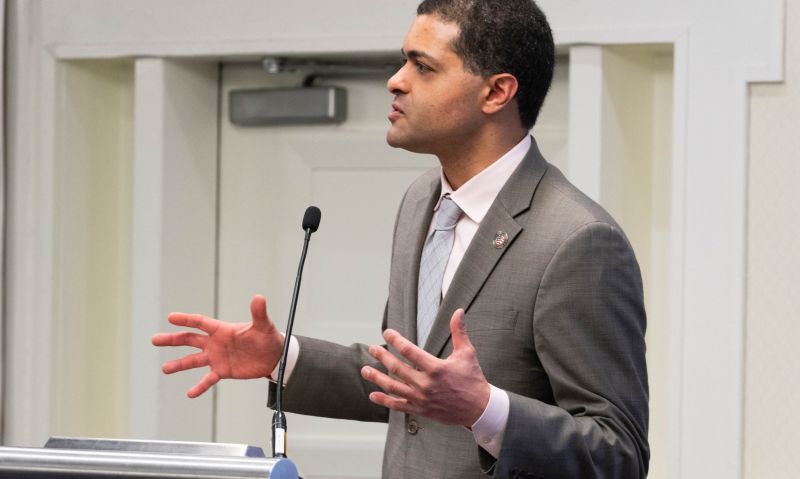
VA top health official: Veteran suicides ‘a public health scourge’
Standing in front of The American Legion’s Veterans Affairs & Rehabilitation Commission on Feb. 27, Department of Veterans Affairs Under Secretary for Health Dr. Shereef Elnahal listed six priorities for the Veterans Health Administration.
Among those priorities shared by Elnahal: Prevent Veteran Suicide. And though it was the last item on the list, it was by no means the least important.
“Our top and most important clinical priority … is preventing veteran suicide, which is a public health scourge. We will not be satisfied until we get to zero,” Elnahal said during The American Legion’s Washington Conference in the nation’s capital. “We have a well-published and socialized public health plan on veteran suicide, but we need to get the word out that almost every veteran in the United States now qualifies for VA emergency suicide care for 30 days and outpatient care for up to 90 days. That is just a ground-breaking thing that will allow us to reach this category of all veterans. You don’t have to be enrolled in VA healthcare. You don’t even have to be an applicant yet to (the Veterans Benefits Administration).
“We’re trying to get the word out through as many avenues as possible. I hope you will help us do that.”
Elnahal said VA is reaching out to community organizations and others to assist their efforts, including The American Legion. “I am here with a request,” he said. “This is a major thing that I’ve been telling my own staff. The need to partner with (veterans service organizations) is extremely important. Let us know where you’re not receiving open arms on that, because that is my expectation across the country – that we invite The American Legion and other VSOs into our organization to help us execute these priorities.”
The other priorities Elnahal shared updates on were:
· Hire faster and more competitively.
· Accelerate our journey to high reliability.
· Connect veterans to the soonest and best care.
· Support veterans’ whole health, their caregivers and survivors.
· Serve veterans with toxic exposure.
Alfred Montoya, Acting Assistant Under Secretary for Health for Support Services in the Veterans Health Administration, also spoke about PACT Act implementation, including toxic exposure screening for those enrolled in VA healthcare. Screenings take five to 10 minutes once every five years and can be done at any VA medical center or clinic.
“We’re looking to make sure that that screening is quick, it’s efficient, and it also points you to the care and services that you need,” said Montoya, who also reminded those in attendance that VA created a special enrollment period for veterans meeting the eligibility criteria but were discharged before Oct. 1, 2013. Those veterans can receive care and enroll during a special enrollment period that started Oct. 1, 2022, and ends Oct. 1, 2023.
“It’s very, very important to remember this, because once this timeframe goes by, then that eligibility window does close for enrollment in health,” said Montoya.
Jaime Areizaga-Soto, chairman of the VA’s Board of Veterans Appeals (BVA), gave an update on the current situation with the board and VA benefits claims, both sharing the agency’s successes and what he considers to be challenges.
“Last year we held more hearings than ever in the history of the board – over 30,000 hearings,” Areizaga-Soto said. “Another piece of good news is we are clearing the legacy appeals hearings (claims for which VA provided notice of decision prior to implementation of the Veterans Appeals Improvement and Modernization Act of 2017 (AMA) and the claimant has not elected to participate in the AMA process) this year. Most likely by summer, we’ll have cleared all the hearings on the legacy side. That sounds like good news, but there’s always a caveat.
“This is the bad news: Many of those hearings are heard and then they’re put on the shelf, and you’re not getting a decision for a long time. I like baseball, so when I tell people this, this is like getting to third base and then staying on third base for a long time. That’s one of the two numbers that keeps me up at night: appeals pending.”
Areizaga-Soto said the board has made more than 90,000 decisions over the past three years; the goal this year is 103,000. “It sounds like a great number, the highest in the history of the board. Great job,” he said. “I’ll give you the catch there. The line is moving faster, but the line is getting longer. And those 103,000 decisions, many of them are remands. It can’t be like that. We’ve got to bring resolution to our veterans.”
Matthew Quinn, VA’s Under Secretary for Memorial Affairs, said more than 150,000 veterans and family members were interred in national cemeteries in 2022, while approximately 47,000 more had their final place in a grant-funded state, territorial or tribal cemetery. But Quinn said he’d like those numbers significant higher.
“But in terms of usage – of our national cemeteries, or our state, tribal or territorial grant-funded cemeteries – only about 15 percent of veterans each year utilize our national cemeteries,” Quinn said. “About 15 percent in our national cemeteries and 5 percent in our grant-funded cemeteries. I’d sure like to increase the number of veterans who know that they have a place of honor for them for perpetuity within one of our national cemeteries or grant-funded cemeteries.”
